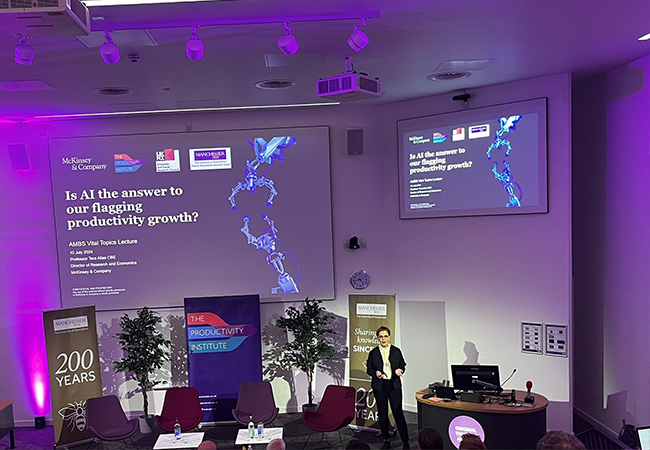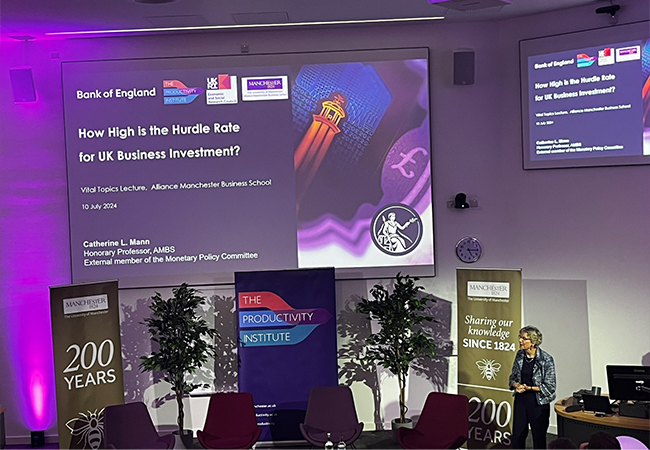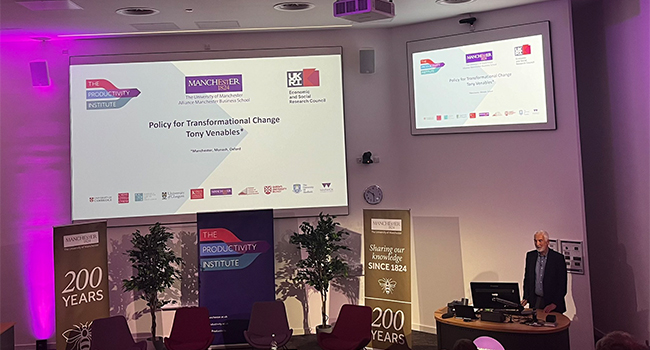How productivity can fundamentally alter the path of economic progress and business success
Tera Allas, Catherine L. Mann and Tony Venables are experts on productivity and its potential to fundamentally alter the path of economic progress and business success. The three are Honorary Professors at Alliance Manchester Business School (AMBS), which is the headquarters of The Productivity Institute. To mark their appointment, they gave lectures at AMBS’ Vital Topics event on 10 July. This blog provides an overview of their discussions. To re-watch the lectures, visit the Alliance Manchester Business School YouTube page.
Is AI the answer to our flagging productivity growth?
 Productivity growth is pivotal for the nation’s gross domestic product, yet the UK’s productivity has been stagnating. Tera Allas CBE, Senior Advisor at McKinsey & Company, explored whether artificial intelligence (AI) could be the remedy for the issue of productivity growth in the UK.
Productivity growth is pivotal for the nation’s gross domestic product, yet the UK’s productivity has been stagnating. Tera Allas CBE, Senior Advisor at McKinsey & Company, explored whether artificial intelligence (AI) could be the remedy for the issue of productivity growth in the UK.
Tera highlighted the potential of digital, automation, and AI technologies to boost productivity substantially. However, she cautioned that AI alone is unlikely to produce transformative impacts at a macro level without concurrent investments in equipment and skills.
There is substantial potential for automating work, with nearly a third of tasks being automatable by 2030, according to McKinsey Global. While AI adoption is accelerating, the range of possible adoption scenarios is broad and influenced by various factors. Generative AI could revolutionise productivity, especially in innovation-driven tasks such as research and development (R&D).
Experiments indicate that workers utilising generative AI tools experience significant productivity gains at the task level. However, the broader economic impacts remain uncertain. Unlike traditional software, AI technologies diffuse in a decentralised and embedded manner, with businesses and individuals adopting diverse AI solutions.
For AI to truly enhance productivity, complementary investments in human capital and software are crucial. Investing heavily in software, but not in training will not lead to high productivity growth; similarly, large investment in training without investing in software will also limit productivity gains. The greatest productivity gains are observed with moderate investments in both areas. Transitioning to higher-wage occupations will require competencies in social, emotional, and technological skills.
While AI and automation offer promising avenues for productivity growth, their impact is contingent on a supportive ecosystem. This includes skills development, infrastructure investment, and coordinated policy interventions.
How high is the hurdle rate for UK business investment?
 Catherine L. Mann, External Member of the Monetary Policy Committee at the Bank of England, tackled the subject of the hurdle rate for UK business investment in her lecture. The hurdle rate, a critical benchmark for business investment decisions, is the minimum acceptable rate of return on investments that must be achieved before management considers it acceptable.
Catherine L. Mann, External Member of the Monetary Policy Committee at the Bank of England, tackled the subject of the hurdle rate for UK business investment in her lecture. The hurdle rate, a critical benchmark for business investment decisions, is the minimum acceptable rate of return on investments that must be achieved before management considers it acceptable.
Business investment can be divided into three different perspectives: from an economist, from a manager, and from a financial investor. Each of these perspectives has frameworks that consider factors relevant for business investment, which may differ from each other in some senses, but overlap in others, meaning that these three perspectives are importantly intertwined. With the availability of firm-level data, investor-level data, and manager-level assessments, research can combine the three perspectives to get a view of what matters most for UK business investment. To find out more on this, read her paper for the UK Productivity Commission.
There is also an important distinction to be made between “real” investment, such as capital equipment, intangibles, or real estate, and financial investment, such as cash holdings, mergers and acquisition, or payouts through stock buybacks or dividends. Financial investment decisions do not have the same productivity-enhancing effects as “real” investment.
In her lecture, Catherine explained that the manager’s hurdle rate often exceeds other cost of capital measures and varies according to firm size, financing source, and sector. Interestingly, many firms (often smaller firms) do not use hurdle rates at all, suggesting that product market conditions, firm characteristics, and managerial quality also play significant roles in investment decisions. While the hurdle rate is a key factor, it is not the sole driver of investment.
A high hurdle rate for business investment may be a factor in short-termism in UK business decisions. Policy considerations to enhance business investment in the UK should address market failures, improve the business environment, and ensure access to finance. A comprehensive approach to understanding and influencing investment behaviour, considering all perspectives, is essential to stimulate economic growth.
Policy for transformational change
 Tony Venables’ lecture focused on the principles of policy design and project appraisal in the context of transformational change. He explained that the market system, coupled with state action, puts the economy in a state of equilibrium: where economic forces are balanced, and variables remain unchanged in the absence of external influences.
Tony Venables’ lecture focused on the principles of policy design and project appraisal in the context of transformational change. He explained that the market system, coupled with state action, puts the economy in a state of equilibrium: where economic forces are balanced, and variables remain unchanged in the absence of external influences.
This is an efficient state, except for distortions, often called ‘market failures’, such as monopoly power, climate change, pollution, congestion or artificial barriers to trade. Policy should be designed to target and fix these distortions, while also paying attention to the direct and indirect effects of these policies.
Transformational change refers to an input to a system, like a policy, that causes a change that is not reversed even if the initial inputs are removed. This often involves multiple equilibria, with the system being shifted from one equilibrium to another. For instance, the town of Qiaotou is known as the “button capital of the work”, manufacturing 60% of the world’s supply of clothing buttons and 80% of the world’s zippers. Why is this the case? There is no reason why it has to be in this location, but it would take a significant, transformational change to shift to another market state where this isn’t the case. Existing complementarities make it cheaper for firms to stay within that cluster, and a firm is unlikely to be the “first mover” to leave the cluster as it is a risk with a lot of unknowns.
Tony emphasised that policy aimed at targeting distortions is crucial for triggering complementarities and investment. Achieving transformational change requires multiple coordinated policies to address various distortions simultaneously.
Examples of transformational change, such as climate policy, transport infrastructure, and urban regeneration, where there is a need to shift from one equilibrium into another, necessitate a strategic approach that goes beyond traditional cost-benefit analysis. The appraisal and design of such policies must balance the strategic case with the economic case, considering different scenarios and being transparent about assumptions and uncertainties.
Policy for transformational change must be holistic, recognising the interplay of various factors and the need for coordinated action across multiple fronts to achieve significant and lasting economic impacts.





